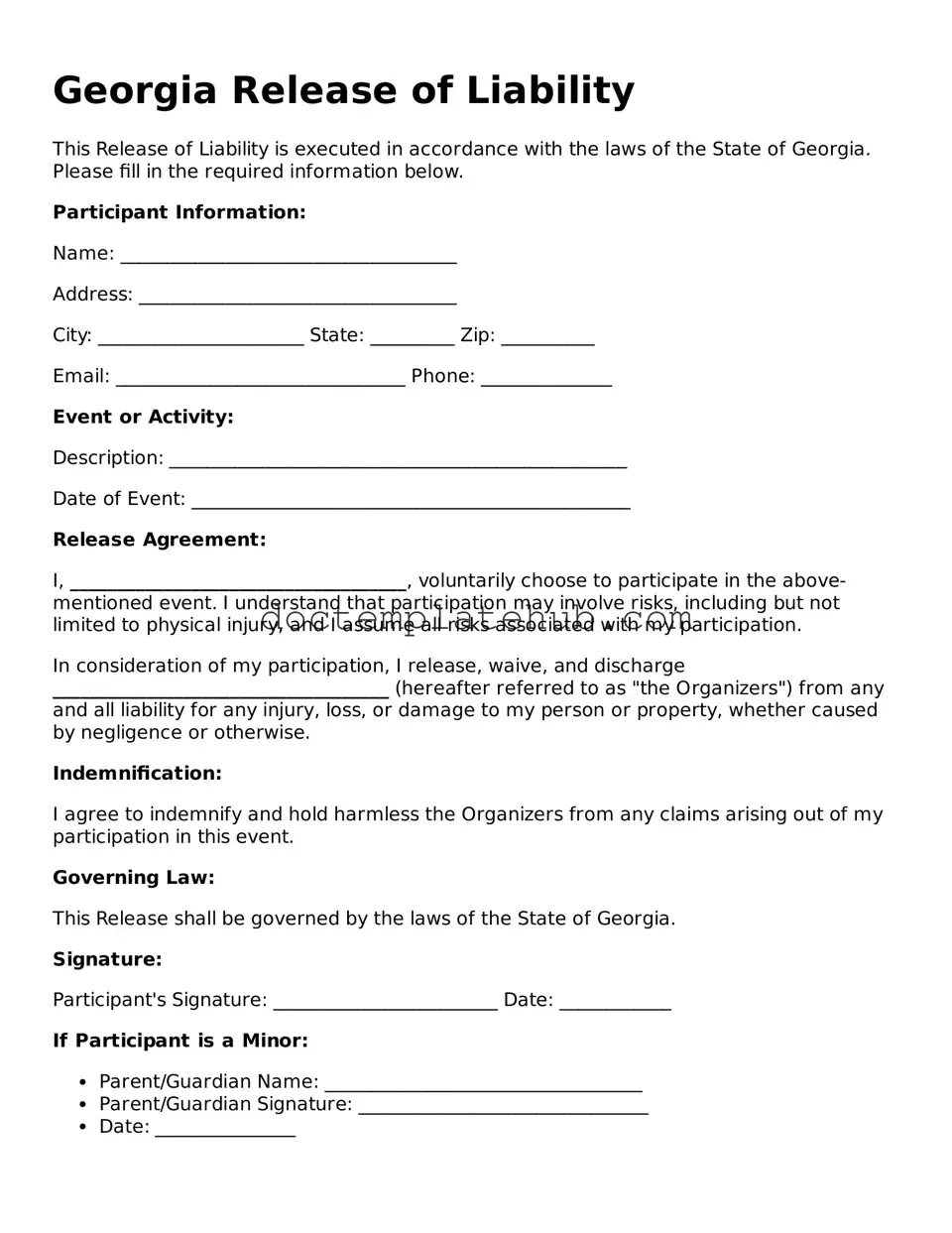The Waiver of Liability form serves a similar purpose to the Georgia Release of Liability form. Both documents are designed to protect an organization or individual from legal claims arising from injuries or damages that may occur during an activity. By signing a Waiver of Liability, participants acknowledge the risks involved and agree not to hold the organization responsible for any accidents that may occur. This mutual understanding helps create a safer environment for both parties involved.
The Hold Harmless Agreement is another document that shares similarities with the Georgia Release of Liability form. In this agreement, one party agrees to indemnify and defend another party against any claims or damages that may arise from specific activities. Like the Release of Liability, the Hold Harmless Agreement emphasizes the acceptance of risk and helps shield the party from potential lawsuits, making it a valuable tool in various contexts, from recreational activities to business transactions.
The Consent to Participate form is often used in conjunction with the Georgia Release of Liability form. This document requires participants to acknowledge their understanding of the risks associated with an activity and to provide their consent to participate. While the Release of Liability focuses on limiting liability, the Consent to Participate emphasizes informed consent, ensuring that individuals are aware of what they are getting into before engaging in an activity.
The Assumption of Risk Agreement is closely related to the Georgia Release of Liability form. In this document, participants explicitly acknowledge the inherent risks associated with a specific activity and agree to assume those risks. This agreement reinforces the understanding that participants are aware of potential dangers and are willing to take responsibility for their own safety, which can help limit liability for the organizing party.
The Parental Consent form is particularly relevant in situations involving minors. This document allows a parent or guardian to grant permission for a child to participate in an activity while also acknowledging the risks involved. Similar to the Georgia Release of Liability form, the Parental Consent form seeks to protect the organization from legal claims by ensuring that parents understand the potential hazards and agree to their child’s participation.
The Medical Release form often accompanies the Georgia Release of Liability form, especially in athletic or recreational settings. This document grants permission for medical treatment in case of an emergency and acknowledges that the participant is aware of the risks involved. While the Release of Liability focuses on limiting claims, the Medical Release ensures that appropriate care can be provided if needed, thus safeguarding both the participant and the organization.
The Liability Insurance Waiver is another document that aligns closely with the Georgia Release of Liability form. This waiver indicates that a participant understands they are not covered by the organization’s insurance policy while engaging in a specific activity. By signing this waiver, participants acknowledge their acceptance of risk and agree to take responsibility for any injuries or damages that may occur, further protecting the organization from potential claims.
In the realm of legal documents, understanding the distinctions among various agreements is crucial, particularly when it comes to safeguarding sensitive information through instruments like a New York Non-disclosure Agreement. This agreement plays an essential role in business negotiations, ensuring that parties maintain confidentiality regarding critical information. For those interested in templates for these documents, resources such as smarttemplates.net can be invaluable in facilitating the creation of compliant and effective agreements.
The Release of Claims form serves a similar function to the Georgia Release of Liability form by allowing participants to relinquish their right to sue for any injuries or damages incurred during an activity. This document provides clarity on the understanding between parties and reinforces the idea that participants are aware of the risks involved. By signing, individuals affirm their decision to participate despite the inherent dangers, which helps mitigate legal exposure for the organization.
The Volunteer Waiver of Liability is particularly relevant for organizations that rely on volunteers. This document protects the organization from legal claims arising from injuries sustained by volunteers while performing their duties. Much like the Georgia Release of Liability form, it requires volunteers to acknowledge the risks associated with their activities and to agree not to hold the organization liable for any accidents, thereby fostering a safer volunteer experience.
Finally, the Event Participation Agreement is similar to the Georgia Release of Liability form in that it outlines the terms and conditions under which participants agree to engage in an event. This agreement typically includes a waiver of liability clause, ensuring that participants understand the risks and agree not to hold the organizers responsible for any injuries or damages. By clearly defining expectations, this document helps create a safer environment for all involved.
